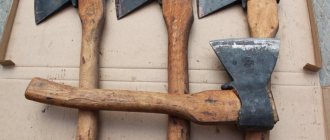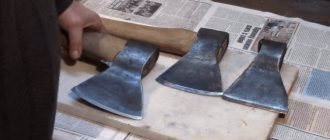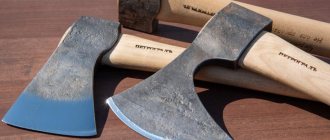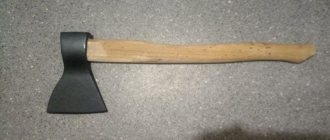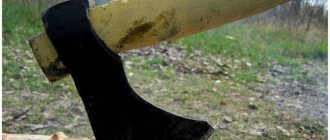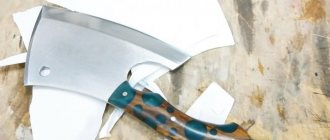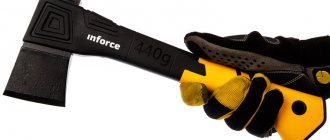The quality of an axe, such a useful and necessary tool in everyday life, is one of the main factors when choosing it. It should be practical, comfortable to use and fit well on the axe. The presence of these signs significantly increases labor productivity and protects a person from possible injury. Our recommendations will help you put the ax on the ax handle correctly so that it does not fly off. The attachment will hold well if you wedge it and secure it properly.
Types of ax
Due to the fact that an ax is a rather traumatic tool, and working with it involves intense dynamic physical activity, it is necessary not only to be able to handle it, but also to make sure that it is firmly seated on the ax handle. Not everyone realizes that an ax wedge flying off the handle can cause serious damage to health. Therefore, it is extremely important for a person who often works with this tool to master the skill of attaching an ax to an ax handle.
Today you can find about 10 different types of chopping tools. And each of them has its own specific method of planting. Accordingly, before starting the procedure itself, it is advisable to decide what type of weapon you will have to deal with. At first glance, it may seem that there are no characteristic differences between the varieties. However, despite the fact that the design of the ax is unchanged (it consists of a handle and a metal wedge), each type of weapon has its own distinctive features and purpose. For example, an ax can be: carpenter's, combat, tourist, or specially designed for a woodcutter.
Attaching the ax
Attaching the ax handle to a metal wedge can be done in several ways.
- Welding. Thanks to this method of fastening, it is possible to achieve high strength and reliability of the implement during operation.
- Manufacturing of ax elements as a single structure. Characterized by rigidity and strong feedback when working with such a tool.
- Gluing of structural elements of the ax in specially designated rooms. Epoxy material is used for gluing. And the ax handle is made of polymers. It is quite difficult to carry out such a procedure on your own, since the manufacturing process will require a room with recirculation ventilation.
- Putting a metal wedge on the handle of a gun and then wedging it. This method is considered optimal for carrying out this procedure independently. If the recommendations are strictly followed, the tool is characterized by fastening strength.
It is worth noting that the successful execution of putting an ax on an ax handle depends on the availability of existing skills, knowledge and the required tools.
It is possible to carry out such a procedure on your own, but you need to objectively assess your abilities. Because if the metal wedge is not securely attached to the handle, the tool will become loose after a period of intensive work. Thus, planting will have to be done again.
How to remove excess metal hardness yourself using tempering
Tempering removes the excessive hardness and brittleness of the material acquired during hardening. Tempering is essentially the same heating to a critical point and slow cooling in air, when the structural lattice changes again.
- Tempering at low temperatures requires gentle heating to 250ºС. It removes structural stress and maintains high strength. Suitable for cutting and piercing tools made of carbon material, as well as low-alloy steel.
- Tempering at average temperatures already requires intense heating in the range from 350ºС to 500ºС. It makes it possible to achieve such transformations of atoms when the structure becomes uniformly fine-grained, and therefore elastic and wear-resistant. Parts under dynamic load - springs, spirals - are subjected to this tempering.
- Tempering at high temperatures requires high heat in the range from 500ºС to 700ºС. Then a structural shift occurs, returning the over-hardened part to viscosity and ductility while maintaining the highest strength. Such tempering is required for parts subject to shock loads.
To summarize, it is necessary to clarify the picture of the process during vacation. In the first case, a slight decomposition will be observed in the metal, in the second, decomposition will occur, but the restructuring of the structure will not begin, in the third, a restructuring of the structure or crystalline structure of the grains will occur.
Placing an ax on an ax handle
At first, such a procedure seems simple. This false impression is formed due to the simple connection of elements - mounting and wedging. However, the procedure is quite labor-intensive and has a number of subtleties that in no case should be ignored. To make this job easier, a professional and experienced carpenter always follows strict step-by-step instructions.
Preparatory work with the tool
First of all, you need to get an ax handle. You can buy it at any specialized store or make it yourself. The ideal material is pre-dried birch. Carpenters with extensive experience prefer wood of this particular species. It has the necessary set of properties and that is why it is so popular. When choosing a handle, it is recommended to pay attention to its density and shape. An important criterion is grip comfort. If you do not take this point into account at the initial stage, your hands will experience discomfort while working with an ax, which will quickly lead to severe fatigue.
Next, you will need to purchase a handle of suitable dimensions that will fit tightly into the metal hole. Using a woodworking device or a sharp knife, it is necessary to trim the handle so that it acquires the required shape (straight or ellipsoidal). The ellipsoidal hole in the ax is considered more reliable due to its fastening. Small cuts are then made on the top surface of the handle. Visually they resemble longitudinal grooves.
The most important nuance at this stage is the depth of the grooves. The cut grooves should be hidden in the hole of the axe. Otherwise, during the wedging process or during use, the handle may simply crack. It is necessary to strive to ensure that the width and thickness of the wedges are the same.
Creating wedges
The reliability of fasteners is largely due to high-quality wedging. The use of wedges made of metal and wood will help with this. As in the case of an axe, wedges can be purchased in a specialized department of the store or made at home. An important condition is compliance with the shape and size between the wedges and the material used in the manufacture of the axe. The best wooden wedge, according to professional carpenters, is made from dried birch, and the best metal wedge is made from hard tin, the so-called shovel.
Perhaps the main difficulty faced by everyone who decides to mount an ax on a handle themselves is driving in steel or wooden wedges. In fact, this process is not as complicated as it might seem at first glance. This stage can only be started after the handle and wedges have been completely prepared. To begin with, the longitudinal wedges are hammered in using light blows with a hammer. It is not worth making strong blows due to the fact that the wood may be deformed. And this can subsequently lead to instability of further fastenings.
Once the wedges fit snugly into the grooves, use a hacksaw blade to carefully cut off the remainder. You can verify the successful completion of the work by the strength of the grip of the ax and the handle.
Wedging
There is an opinion that a wooden wedge must be made from the same type of wood as the handle. However, this is a misconception. The main condition when choosing a material is its strength. In turn, the direction of the wood fiber should also be taken into account, since it is recommended to maintain parallelism in the narrowing of the wedges. This will protect the weapon from possible damage.
Successful wedging can be considered complete filling of the groove space with wedges, and removing the ax from the ax handle is considered impossible.
Sometimes it is still not possible to avoid gaps in the ax hole. Then an ordinary piece of gauze, which has been previously treated with epoxy resin, will come to the rescue. This composition allows you to provide wood with protection from moisture and impart reinforcing properties. To remove any gaps that have arisen before mounting the ax, its upper part is wrapped several times with treated gauze. Thanks to epoxy resin, any gap, crack or gap is filled, forming a reliable and strong attachment of the ax to the handle.
Self-production of a wood splitter
Making a mechanical cleaver for firewood with your own hands using a spring mechanism is not a difficult task, especially if a person has initial experience with welding. Although, on the other hand, bolted connections can also be used. In this case, the tools you will need are a grinder and a drill. They are not difficult to work with, so even without previous experience, making a wood splitter will not be difficult.
This diagram will help you make your own mechanical cleaver
The design of the cleaver can be any, the main thing is its power, quality of production and stability. But before production begins, it is necessary to make correct calculations and prepare drawings. In this case, it is not difficult for even a novice craftsman to make a firewood splitter with his own hands, and the quality will be quite good.
It is important to calculate what the optimal length of the lever will be in relation to the load on the blade. It is also important to adhere to the correct location of the spring and hinge, the distance between them
Try to choose higher quality materials for your cleaver that will last you for many years
If you incorrectly calculate the dimensions of the structure, the product will not fully perform its function. For example, a cleaver can be very weak, so you will need to put in a lot of effort. The operating principle is easy to understand. The farther the spring is fixed from the hinge, the more power the cleaver will have, but at the same time the length of the lever should increase equally. You need to find the ideal place where the spring will have sufficient force, and it will not be difficult to subsequently raise the lever and tension the spring.
To produce a simple lever wood splitter, you can use available materials:
- shock-absorbing spring from a passenger car (VAZ or similar);
- a ready-made blade for a cleaver or a steel blank for self-production;
- a pipe whose diameter coincides with the diameter of the spring;
- steel pipes, profiles and other rolled metal for the manufacture of frames.
Conical threaded wood splitter:
To make hinges, it is not necessary to use a mechanism on bearings. The design itself turns out to be quite massive, so an ordinary shaft and bushing is sufficient. The same mechanisms are installed as hinges on gates.
The manufacturing process is also simple. In each individual case, it is necessary to rely on prepared calculations and drawings, and they may be different. All actions must be performed in the following sequence:
- measure and cut frame elements using a grinder;
- assemble the frame using welds or bolted joints;
- bowls are made and a spring is installed;
- At the last stage, the weight and the cleaver blade are attached.
If the structure is not very stable, then additional pipes are welded to the bottom to increase the supporting area.
Correct cleaver with your own hands:
The main thing is to adhere to general manufacturing recommendations and follow the drawing. For a simpler option, you can make an ax-shaped cleaver, but with an elongated handle and a heavy cutting part. Even the most primitive model will help the owner in preparing firewood for the winter.
Cleavers have been known since ancient times - this is a type of ax distinguished by the increased weight of the chopping part and the special sharpening of the blade. Their task is not to chop the log, but to split it. At the moment the iron face of the tool hits the tree, an ordinary ax sticks into it and gets stuck. The cleaver, having greater mass and a dull blade, splits the tree into two parts under the influence of the force of the blow. There are many configurations of cleavers. They differ in shape, weight, sharpening angle, handle length and other design characteristics. At the moment, there are modifications of cleavers in electric, gasoline, semi-automatic, manual form and even cleavers for bricks.
How to attach an ax to an ax handle: step-by-step instructions, tips, features
- November 9, 2018
- Equipment
- Ivan Gresko
In order for wood to be cleaved continuously, the working tool must be properly prepared. Beginners often ask the question: how to attach an ax handle to an axe? According to experienced carpenters, this is not difficult to do. To do this, it is enough to know a few nuances. Information on how to properly place an ax on an ax handle is contained in this article.
Getting to know the chopping product
A chopping tool can be a carpenter's tool, a fighting tool, a camping tool, or a woodcutter's tool. Before placing an ax on an ax handle, you need to decide which type it belongs to. Despite the fact that any ax has a handle and a metal part, each type has its own purpose and design features. Due to the fact that an intense dynamic load is placed on the chopping tool, it is important that the ax is mounted correctly on the shaft. Otherwise, it will fly off the handle and injure a person.
Making a storage case
When you have made a taiga or other ax from an old one with your own hands, sew a bag for it. It is safe to transport and store tools in it. Make a case from durable material, taking into account the size of the ax. There are three simple options:
- You can easily make a case for an ax with your own hands from a bag or an old briefcase. Draw contours with allowances on the material. Then sew the leather with a gypsy needle, to make it easier for you to make stitches, use an awl.
- Make your own ax bag from old leather. Craftsmen advise making the case from thick leather. Draw the head on the inside with a pencil, and then cut out two identical parts and sew them together.
How to attach an ax handle to an axe?
This work involves attaching a metal working part to a wooden handle, followed by wedging using special wedges. They can be made of wood or cut from sheet metal. At first glance, this connection method seems simple. However, there are several nuances in the work that should be taken into account. For those who do not know how to place a cleaver on an ax handle, experienced craftsmen recommend following the sequence of actions. First you should prepare for work. Then you need to make steel or wood products for wedging. Only after this can you proceed directly to installation.
Methods for heating a blade to hardening temperature
Many amateur workshops have a muffle furnace, electric or gas. The temperature in its chamber is sufficient for firing ceramics, melting glass and heating metal to the required temperatures.
In the cell
The oven has a temperature regulator, so heat treatment is not difficult. For annealing and hardening of one tool, you can make an electric muffle furnace with your own hands.
How to make a camera yourself
To heat the ax blade, you need a small chamber. Required:
- Body – any metal container with a wall thickness of 2 mm or more.
- The heat insulator is a mixture of fireclay clay and refractory brick chips.
- The heating coil is a wire made of fechral alloy.
- Thermostat.
- Network voltage stabilizer.
Before turning on the stove, you need to check that the wiring is working properly. To achieve the desired temperature, about 4 kW is required.
- A chamber is made from the refractory mixture, and grooves for the heating coil are laid in it. Allow it to dry, lay the spiral, cover it with a layer of clay, and bring out the ends of the wire to connect to the network.
- The dried heating chamber is inserted into the housing. The ends of the spiral are connected to the thermostat terminals.
Before making a muffle furnace yourself, study detailed instructions and watch videos of experienced craftsmen.
On an open fire
To reach 800 degrees, you need coals. It’s better to build something like a blacksmith’s forge from a bucket or barrel. In camping conditions, a large fire is lit. There must be a constant supply of oxygen to the coals.
A kind of bellows for blowing is made from a plastic bag. Use a boat pump and other available means. The coals should burn as brightly as possible. The ax blade is ready for hardening when it turns scarlet.
Preparatory stage
Before attaching the ax handle to the axe, its handle should be treated. It is made from a rough wooden block, mainly from birch. Due to the fact that the metal working parts come in different sizes, shafts are sold a little larger than they should be. This was done to ensure that the ax handle did not dangle and that it fit tightly into the ax. You will have to reduce the diameter of the shaft yourself. The handle is trimmed with a knife or other woodworking tool. Next, using a pencil, mark the contours of the eyes, as well as the places where the wedges will be located. Eyelets can be straight or conical.
Then you need to measure the height of the shaft and mark on it the place to which the ax will be lowered. Afterwards, measure the depth of the cutouts on the handle into which the wedges will be inserted in the future. To make the shrinkage more reliable, these recesses must be smaller than the wedges themselves. Make cuts using a hacksaw for metal. After marking and cutting, the shaft itself is finished. At this stage, craftsmen use sandpaper. It doesn’t matter what grain size it will be. The fact is that rough work will be done with this tool, and then the section of wood will be covered with an ax. Due to this fact, the surface may remain rough. The main thing is not to remove too much.
Secrets of hardening a heat source
There are several options for devices that can bring the heating of a steel part to the desired temperature threshold. The ideal option is an industrial or home-made muffle furnace.
In the absence of such a tool, you can use another home assistant - a blowtorch.
A fairly powerful jet of flame makes it easy to heat parts of small thickness to the required temperature. Remember to move the torch along the plate being hardened to achieve even heating.
In addition, it is possible to use ordinary charcoal together with a blowtorch. To do this, dig a small hole in the soil, pour coal into it, and place the hardened blades of the knives on the edge. Heat the coal together with the plates with a lamp until the latter reaches the required heating. This method prevents the rapid cooling of the unheated part of the workpiece and its overheating.
The third option is to make a small forge. It can be either coal or gas. The main structural elements of the device are the housing and the source of forced air. The base of the coal hearth can be made of a steel sheet 10 mm thick with a piece of pipe with a diameter of about 20 cm welded at the bottom and an outlet from it for connecting a hose from the outlet of a household vacuum cleaner.
Do not forget to drill several holes in the sheet of sufficient diameter to supply air. Wood (barbecue) or coal is used as fuel.
Sources
- https://SevenTools.ru/metally/kak-pravilno-zakalit-topor.html
- https://setafi.com/instrumenty/topor/kak-zakalit-topor-v-domashnih-usloviyah/
- https://smm-star.com/kak-pravilno-zakalit-topor/
- https://VashNozh.ru/topory/zakalka-topora
- https://kovkapro.com/kovka-tehnologiya/zakalka-topora/
- https://printeka.ru/prochee/kak-zakalit-topor-v-domashnih-usloviyah.html
- https://2lzz.ru/stolyarnyj-instrument/kak-zakalit-topor
- https://teplobloknn.ru/metally/zakalka-topora.html
About cuts
Their location is the upper part of the shaft. The cut is a longitudinal groove into which the wedge will be inserted. Often, beginners, in addition to the question of how to attach an ax handle to an ax, are interested in how many cuts should there be in the handle? According to experienced craftsmen, you can limit yourself to one cut that stretches along the end. Judging by the reviews, this method of attachment is the most popular. Less commonly, the ax handle is equipped with one longitudinal and three or four additional ones on the sides. When making a cut, you should take into account its width and depth, which depend on the size of the wedges. They should not enter freely, since the whole point of wedging is lost. At the same time, it is undesirable for the wedges to fit into the cuts too tightly, otherwise the ax handle will simply split.
About making wedges
Quite good wedges are sold in hardware stores. However, it is not difficult to make them yourself. Dried birch is suitable as a material for making wedges. If a home craftsman wants to carry out wedging using metal products, then he will have to cut them out of solid tin. Judging by the reviews, good wedges are made from shovels.
According to experts, driving is a simple process. It is started after the wedges and handle are completely ready. How to put an ax on an ax handle? This is done as follows. The first step is to align the ax and the shaft so that they are located in the same plane. The metal part is seated using a blunt, non-sharp object. For this purpose, it is best to use a board and a weighted rubber mallet, which is used to lay paving slabs. At this stage it is important not to damage the wood. You need to shrink it gradually, removing excess with a sharp knife or sander if necessary. After the ax is seated to its maximum depth, you can begin wedging. More about this below.
Final stage
There is an opinion that wooden wedges should be made of the same type of wood as the ax handle. However, according to experts, the wedges and shaft can be made of different wood. The main thing is that the propping products are durable. During wedging, you should take into account the direction in which the wood fibers are located. They must be parallel to the narrowing in the wedge. In this case, it will not break during the driving process. If the wedge breaks, it will not provide high-quality expansion of the ax handle. The work can be considered successfully completed if the entire cut is filled with the wedge and it is not possible to remove it. The distance between them must be at least 3 mm. The remains of the wooden wedges are carefully ground off.
If the master decides to also use iron ones, then they should be driven in last. The end of the steel wedge protruding from the shaft is bent so that it covers the wooden one.
It happens that the home handyman, due to inexperience, left gaps in the eyelet. The situation can be corrected using a bandage and epoxy resin. You can also use regular gauze. The material is soaked in resin and then wrapped in several layers around the axe. In this case, the resin performs a protective function, namely, it prevents the wood from getting wet. In addition, it is used as a reinforcing agent. Wedging begins after it has completely cooled down. Some craftsmen coat wooden wedges with resin.
Which side should the ax be placed on the ax handle?
A standard Soviet-made ax is equipped with a cone-shaped chopping part. This design has a positive effect on the quality of the instrument. In addition, it is impossible to make a mistake when placing it on the handle. Mostly, the ax is placed with the wide part towards the ax handle, and the narrow part towards the wedge. Thus, the end part of the shaft should protrude 0.5 cm beyond the eye. With this method of installation, the loose chopping part can be easily put into place by tapping the ax on a hard surface.
Carpenter's ax - what should the correct argun be?
Since humanity mastered metal, the ax has become an integral tool present in every household, and it has survived almost unchanged to this day. Among all types of axes, it was the carpenter's ax that was the very tool that was once used to build houses, since it is moderately light enough to climb with it even to a height and work there, holding the tool in one hand. For the same reasons, you should choose it today - of course, you are unlikely to build a hut, but in farming and construction there are a lot of tasks that are important to perform while holding an ax in one hand.
Therefore, choose a tool that is no heavier than one and a half kilograms; with this weight, the optimal length of the ax will be about 45-50 cm.
You can find out the optimal dimensions for yourself only experimentally - take the product in your hand, feel its weight, evaluate the ease of gripping the handle, wave it several times. Nobody can tell you the ideal proportions - everyone has their own individual requirements. It is important that the cross-section of the ax has the shape of a drop - for centuries this shape was considered the most convenient for stable fixation, and modern technologies have only confirmed the rightness of our ancestors. If you want to truly love your tool, buy the metal part of the ax and the ax handle separately, in which case you can fit it, as they say, to your hand. In this case, you will need to master a separate science - how to wedge an ax!
Structural elements
An ax consists of a head and a handle called an ax handle. Depending on the purpose, the shape may change slightly to adapt to specific jobs, but the configuration as a whole is unchanged.
Upon closer examination we can distinguish:
- eye - this is a hole used to fix the ax;
- beard - serves for more reliable mating of parts by increasing the support area; upon impact, it distributes the load transmitted to the handle;
- toe and heel - the upper and lower angles of the blade, a smaller degree will help to perform delicate work;
- blade - the sharpened part, usually 5-10 mm, the angle varies from 25 to 50 degrees, depends on the functionality of the product, the metal in this area is subjected to hardening;
- cheeks - side parts. The longer they are, the deeper the tool can penetrate into the processed raw material with a single blow;
- Tail - necessary to prevent the tool from slipping during operation, serves as a kind of stop;
- Butt - used for impact, can be used instead of a hammer for imprecise and few jobs.
Wedge with wedge - wedge the ax!
In fact, there is one huge advantage in doing wedging yourself - you will be 100% confident in the safety of the tool and will be insured against accidents that may happen if other people perform this procedure poorly. Most often, purchased products are wedged with just one long, vertical wedge, whereas in the old days they knew that this needed to be done with at least three, and even better, five wedges.
The first method is cross-shaped wedging. It is very simple to do - one wedge is driven in the center over the entire width, then along the wedge from above and below. True, if you have a high eye of the ax relative to the width, then the sectors separated by wedges turn out to be quite thick and not flexible enough. By hammering in the wedges, you can get a crack, if not the entire handle, then half the handle. The second method is 5 wedges. Relevant if the ax is large and the eye is long enough. In this case, it is better to divide the handle into 6 sectors, which will be thinner and more flexible. Wedging is performed with five wedges, which are driven into two transverse and three vertical slots.
Made of plastic
Making a cover is not difficult if you use plastic that softens when heated.
Many similar artificial materials have these properties. The easiest way to make a case is from plexiglass or polyvinyl chloride. Required tools and materials:
- PVC pipe 100 mm, PVC or plexiglass sheet;
- hacksaw, saw, jigsaw;
- hair dryer, burner, metal bath.
Step-by-step manufacturing instructions
In the case of using sheet PVC, make a drawing of the cover as described above.
It is better to outline the ax along with the handle. It is necessary to leave a margin of 10-20 mm around the perimeter.
Then do this:
- Mark the place for the bend (a strip slightly larger than the width of the butt).
- Heat the sheet in the middle of this strip.
- Place the ax and bend the plastic.
- The place where the ends meet is heated well, one is wrapped and welded.
- It is processed with a file or “sandpaper”.
- A lid is made from plastic and placed on top or secured on small hinges.
Wedging an ax - step-by-step diagram
Step 1: Making a place to plant the ax
First you need to cut out a place for the ax to fit. This must be done in such a way that the ax handle protrudes from the eye by at least 1 cm - this is a kind of reserve for better holding the ax on the shaft. Try to fit the shape of the seat as closely as possible to the shape of the eyelet.
Step 2: Making the cuts
Using a regular hacksaw for wood, make cuts from the end of the ax handle at a depth of at least 2/3 of the height of the eye, this does not take into account the height of the protrusion.
Step 3: Making Wedges
For wedges, a hard wood such as oak is best. Many people believe that the wood should be the same from which the handle is made, but this is not an entirely correct statement. If the ax handle is birch, then the wedges will be very soft, and you will have to hit them quite hard, and in the end they will simply break. It is important to make wedges in the direction of the grain so that they run along the entire length of the wedge, otherwise even a hard wood wedge will break upon impact.
In this case, it will be almost impossible to get it out of the cut. When the wedges are ready, try them on the cuts, where necessary, reduce the width. By the way, the transverse wedges should be tried on the eye - they should be the same width, since the ax handle will move apart after wedging. With vertical ones it will be more difficult - you need to calculate the total length of the vertical ones, taking into account the width of the transverse ones. The resulting figure should be equal to the height of the eyelet.
Step 4: Epoxy and Gauze
No matter how hard you try, it’s almost impossible to make an ideal ax handle for a specific eye, especially if you don’t often take on such things. There will always be small gaps and voids. In order to avoid this annoying disadvantage, you will need gauze cloth with epoxy resin. Epoxy is an excellent adhesive, does not shrink and forms a monolith when it dries.
Gauze acts as a kind of skeleton that prevents the resin from cracking and crumbling. In total you need to make 4-5 layers of gauze - it depends on the size of the gaps. First, try on the fabric by putting it on the end of the ax handle and placing the ax on it. It should fit tightly, but without much effort. If you are happy with everything, soak the gauze in resin, put it on the ax handle and pull the ax properly. When it is installed, excess tissue should be trimmed.
Step 5: Wedges
Before wedging, pour epoxy into the cuts so that it fills them by a quarter. Filling the cuts with resin will help you out if a crack appears in the ax handle during wedging - the resin will fill it, preventing it from developing in the future. In addition, it will fill voids that may form under the wedges. It is also recommended to moisten the wedges in epoxy and only then hammer them in - first transverse and then vertical.
Step 6: Finishing
If you did everything correctly, then the next day, when the resin has dried, all you have to do is cut off the protruding pieces of the wedges and sand the end. Such an ax will never become loose or dry out.
Source: remoskop.ru
Wedges
According to generally accepted standards, wedges are inserted into an ax made of steel, but the use of wooden wedges is also allowed. They use hardwood deciduous trees. But compared to metal ones, they are significantly inferior in strength. The fact is that when working with a tool all year round, wooden parts gain moisture, and therefore their volume increases. Later, they dry out and the blade becomes very loose. Moreover, wooden wedges must be set on glue, which makes it difficult to re-tamp them in the future.
The wedging process is carried out crosswise. It is better to make a metal wedge for an ax from steel 5 mm thick. Its length should be 5 mm less than the prepared groove depth. Making them yourself is not difficult. To do this, a piece of steel is clamped in a vice, and using a grinder and a metal disc, the excess part is cut off. After which it is given a wedge shape.
To wedge the tool, you need to rest the handle on a hard surface and hammer in 3 wedges
An important clarification: with this method, pressure is created on the walls of the eye, and therefore the smelting of the metal part must be smelted correctly. That is, the blade is harder and the rest is softer
A correctly mounted blade should be no more than 1 cm below its wooden part.
